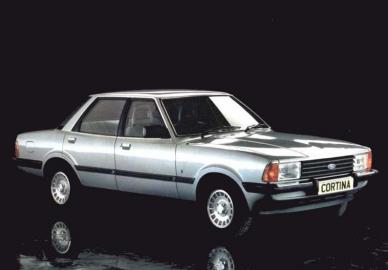Ford Cortina MKV

The history of the Ford Cortina MKV
The Mark V was announced in September 1979. Officially it was known as "Cortina 80", although the Mark V tag was given to it immediately on release, by the press, insiders and the general public.
A large update on the Mark IV, it was really a step between a facelift and a re-body. The Mark V differentiated itself from the Mark IV by having revised headlights with larger turn indicators incorporated (which now showed to the side too), a wider slatted grille said to be more aerodynamically efficient, a flattened roof, more glass area, slimmer C-pillars with revised vent covers, larger, slatted tail lights (on saloon models) and upgraded trim. Improvements were also made to the engine range, with slight improvements to both fuel economy and power output compared to the Mk.IV. For example, the 2.3V6 engine was given electronic ignition and a slight boost in power output to 116bhp, compared to the 108bhp of the Mk.IV. There was also said to be improved corrosion protection on Mk.V models, as a result more Mk.V's have survived, however corrosion was still quite a problem. Cars that were rust-proofed from new with treatments such as Waxoyl or Ziebart have tended to fare a lot better than untreated cars with only factory rust-proofing.
By contrast, the estate models combined the Mk IV's bodyshell (which was initially from the 1970 Ford Taunus) with Mk V front body pressings.
Variants included the Base, L, GL and Ghia variants (all available in both saloon and estate forms), together with Base and L spec 2-door sedan versions (this bodystyle was available up to Ghia V6 level on overseas markets). An optional "S" pack was also available for most models. Various "special editions" were announced, including the Calypso and Carousel. The final production model was the Crusader special edition (although sold in high numbers) which was available as a 1.3, 1.6 and 2.0 saloons or 1.6 and 2.0 estates.
By this time, the Cortina was starting to feel the competition from a rejuvenated (and Opel influenced) Vauxhall, which with the 1981 release Cavalier J-Car, was starting to make inroads on the Cortina's traditional fleet market, largely helped by the front wheel drive benefits of weight and grip.
Up to and including 1981, the Cortina was the best selling car in Britain. Even during its final production year, 1982, the Cortina was Britain's second best selling car and most popular large family car. On the continent, the Taunus version was competing with more modern and practical designs like the Talbot Alpine, Volkswagen Passat and Renault 18, but the brand image of Ford's blue oval ensured the Cortina was a success in virtually every country where it was sold.
The very last Cortina – a silver Crusader – rolled off the Dagenham production line in July 1982 on the launch of the ultramodern Sierra, though there were still a few leaving the forecourt as late as 1987, with one final unregistered Cortina GL leaving a Derbyshire dealership in 2005.
1982 was also the year in which the Cortina lost its title as Britain's best selling car, having held that position every year since 1972. It was still selling well though, and the number one position had been taken by another Ford product: the Escort.
Ford for sale
- Ford Cortina MKV MKV
-
1982 Surrey
 GBP2,195Private sale Views: 12345
GBP2,195Private sale Views: 12345 - Ford Cortina Lotus MK II
-
1968 London
 GBP4,880Private sale Views: 4517
GBP4,880Private sale Views: 4517 - Ford Custom Deluxe
-
1950 Iowa
 US$59,950Trade sale Views: 1566
US$59,950Trade sale Views: 1566 - Ford Cortina MkIII
-
1972 Cambridgeshire
 GBP9,995Trade sale Views: 2190
GBP9,995Trade sale Views: 2190 - Ford Cortina MK II
-
1970 Bristol
 GBP6,995Trade sale Views: 16723
GBP6,995Trade sale Views: 16723 - Ford Cortina MK II
-
1968 London
 GBP3,800Private sale Views: 3828
GBP3,800Private sale Views: 3828


